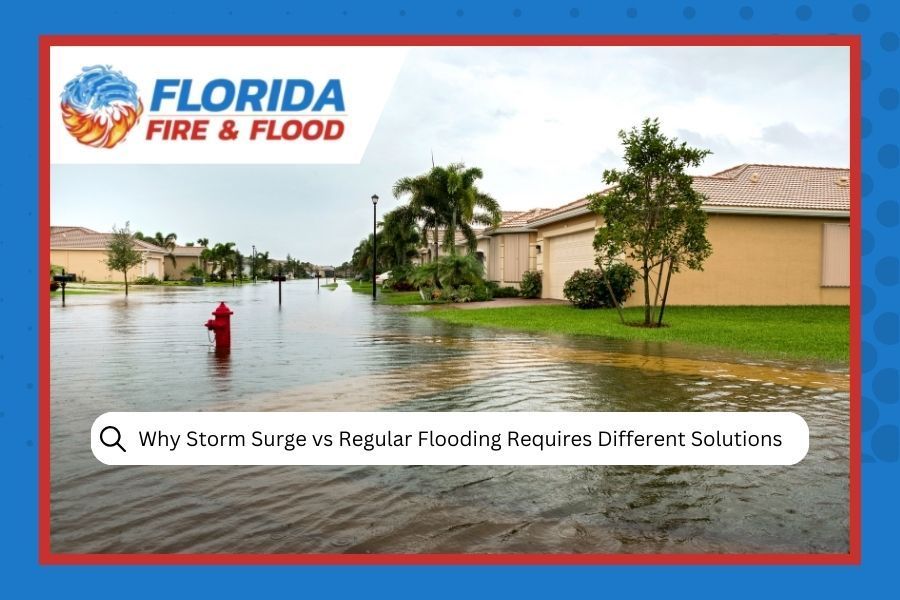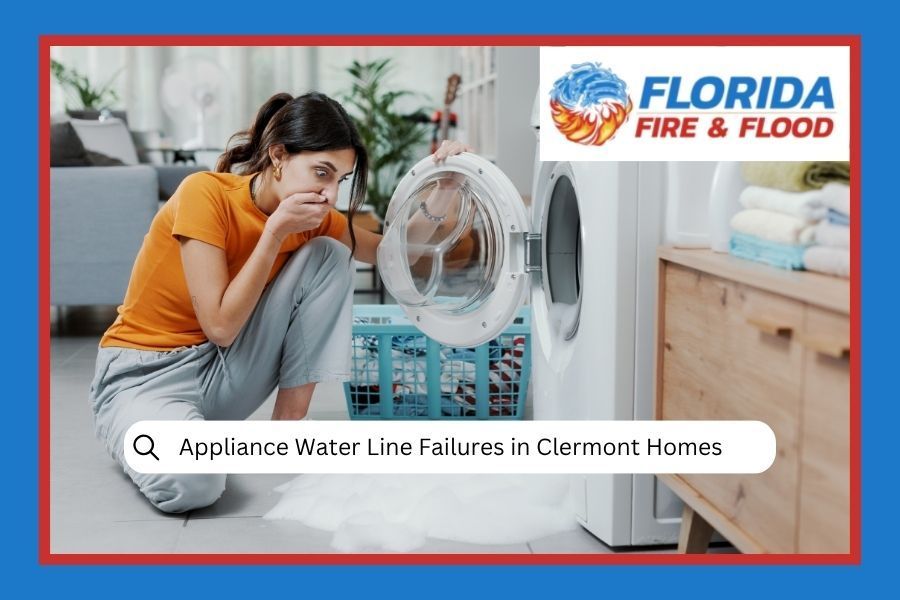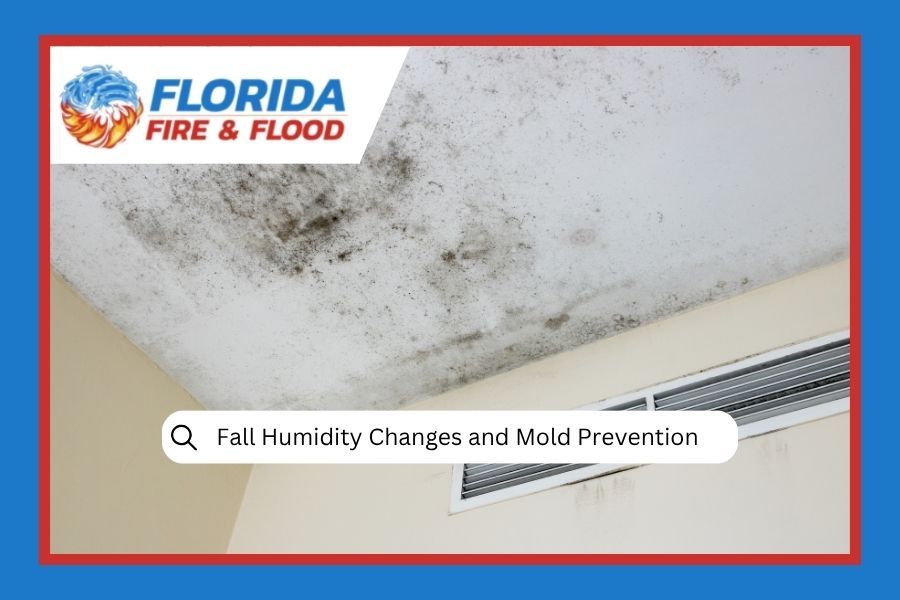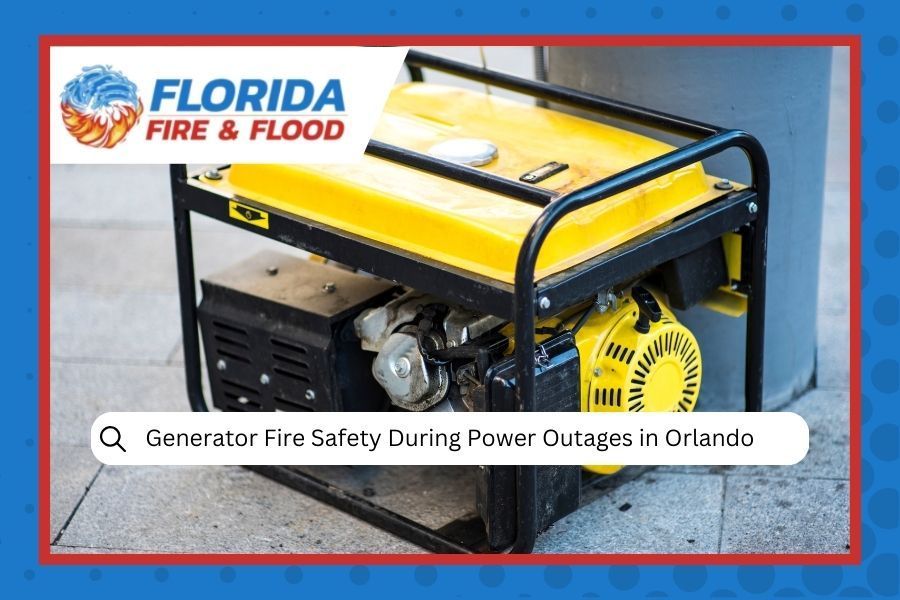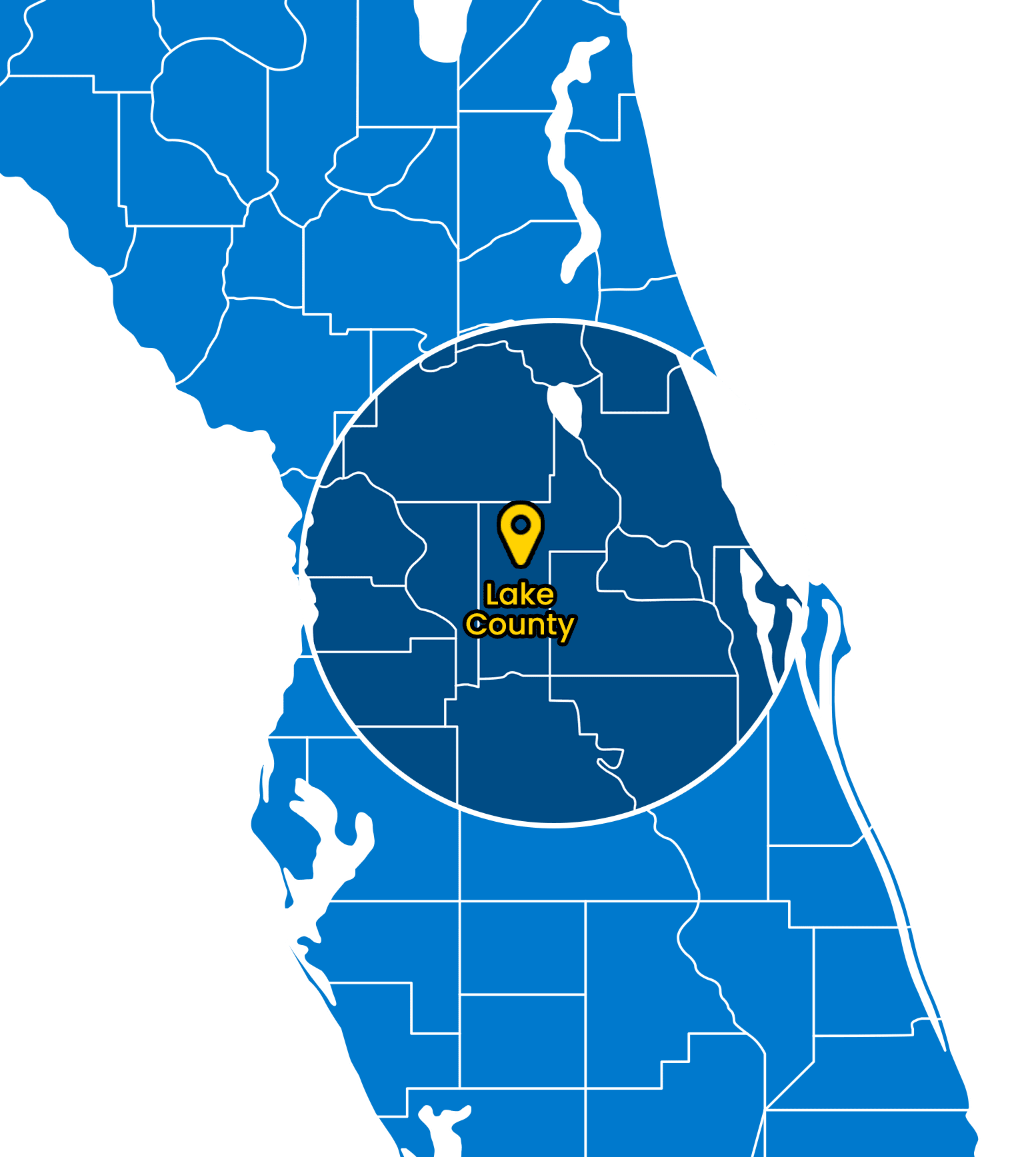AMRT - Applied Microbial Technician I, (Mold Remediation)
Jump to Section:
Living in Central Florida, we've all seen our fair share of water where it doesn't belong. Whether it's from a summer thunderstorm that dumps three inches in an hour or a hurricane that decides to park itself over our state for days, water damage is just part of life here. But here's something that might surprise you: not all flooding is created equal, and the way you handle water damage restoration depends entirely on what type of water you're dealing with.
Storm surge and regular flooding might look the same when you're standing in your living room with soggy socks, but they're completely different beasts that require totally different game plans.
Understanding the Two Types of Water Damage
Let's start with the basics because, honestly, most people don't think about where their floodwater came from until they're knee-deep in it (literally).
What Makes Storm Surge Different
Storm surge is basically the ocean's way of coming to visit you uninvited. When hurricanes or strong coastal storms push massive amounts of seawater inland, that's storm surge. Think of it as nature's version of a really aggressive house guest who brings salt, sand, and a whole lot of attitude.
This stuff is nasty. We're talking about saltwater that's picked up debris from the ocean floor, pollution from urban runoff, and whatever else was floating around out there. Plus, it's been churning and mixing with whatever it encounters on land, creating a toxic cocktail that makes regular floodwater look like bottled spring water in comparison.
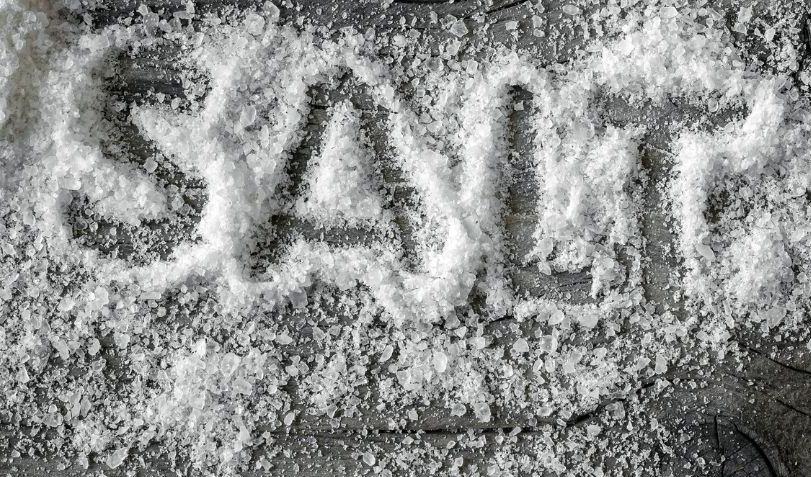
Salt water damage leaves behind crystallized deposits that continue corroding materials long after the water recedes, requiring specialized restoration techniques.
Regular Flooding: The "Cleaner" Cousin
Regular flooding, on the other hand, typically comes from freshwater sources like overflowing rivers, lakes, or just really intense rainfall that overwhelms drainage systems. Don't get me wrong, it's still no picnic, but it's generally not carrying the same level of contamination as storm surge.
This is the type of flooding we see most often in areas like Mount Dora and Orlando during our infamous summer storms or when tropical systems dump massive amounts of rain in short periods.
The Hidden Dangers That Change Everything
Here's where things get really interesting (and by interesting, we mean complicated and potentially expensive).
Storm Surge vs. Regular Flooding: Key Differences
🌊 Storm Surge
- Contains salt, sand, debris
- Highly contaminated water
- Ongoing damage from salt crystals
- Requires complete material removal
- Extended restoration timeline
🌧️ Regular Flooding
- Freshwater from rain/rivers
- Lower contamination levels
- Damage stops when dried
- Some materials can be saved
- Faster restoration possible
Salt: The Silent Destroyer
Storm surge brings salt, and salt is basically kryptonite to everything in your home. It doesn't just evaporate and disappear like regular water. Instead, it crystallizes in every nook and cranny, slowly eating away at metal, concrete, and anything else it can get its mineral-hungry hands on.
There are cases where storm surge damage looked minor initially but turned into major structural issues months later because salt crystals were still working their magic behind the scenes. It's like having tiny, invisible demolition crews working 24/7 in your walls.
Contamination Levels That Matter
Regular floodwater might pick up some dirt, leaves, and whatever was on your floor when it arrived. Storm surge, though? It's like a mobile contamination convention. We're talking about bacteria, chemicals, sewage, and industrial pollutants that have been stirred up from the ocean and everything the water passed through on its way to your property.
Ready to tackle your water damage?
We're here to help 24/7. Don't wait for water damage to get worse.
Get Your Free ConsultationDifferent Water, Different Restoration Approach
Here's where years of restoration experience really come into play. You can't treat storm surge damage the same way you'd handle regular flooding, and here's why:
Storm Surge Restoration: The Deep Clean
When dealing with storm surge, restoration professionals are basically performing surgery on your property. Every surface that touched that water needs special attention:
- Complete sanitization with industrial-grade antimicrobial treatments
- Salt removal from all surfaces, including inside walls and structural elements
- Extended drying time because salt retains moisture longer
- Specialized equipment designed for contaminated water cleanup
- More extensive material removal because contamination penetrates deeper
Regular Flooding: Still Serious, Different Strategy
Regular flooding is no joke either, but the restoration process focuses more on:
- Fast water extraction to prevent secondary damage
- Standard drying procedures with dehumidifiers and air movers
- Mold prevention through proper moisture control
- Structural assessment for water damage and warping
Material Impact: What Stays and What Goes
One of the biggest differences you'll see is in what materials can be saved versus what needs to go.
| Material | Storm Surge | Regular Flooding |
|---|---|---|
| Drywall | ❌ Must Remove | ⚠️ Maybe Salvageable |
| Hardwood Floors | ❌ Must Remove | ✅ Often Salvageable |
| Insulation | ❌ Must Remove | ❌ Must Remove |
| Furniture | ❌ Rarely Salvageable | ⚠️ Often Salvageable |
| Electrical Systems | ❌ Complete Replacement | ⚠️ Depends on Exposure |
Storm Surge: The Great Purge
Storm surge is not forgiving. Restoration typically requires removing:
- Drywall up to at least two feet above the water line
- Insulation that came into contact with the water
- Flooring materials (carpet, hardwood, laminate)
- Electrical components that were submerged
- HVAC ductwork that was contaminated
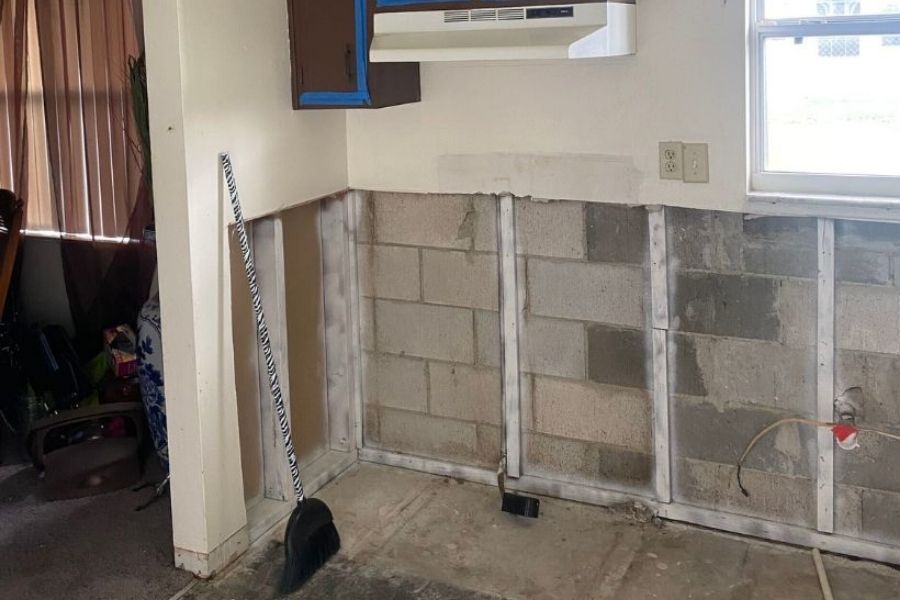
Professional flood cuts remove contaminated drywall well above the water line to prevent ongoing moisture and contamination issues.
Regular Flooding: More Salvage Opportunities
With regular flooding, it's often possible to save:
- Hardwood floors with proper drying techniques
- Some drywall if dried quickly enough
- Furniture and belongings with prompt treatment
- Electrical systems if they weren't submerged
The Time Factor That Makes All the Difference
Here's something that might surprise you: timing matters more with storm surge than regular flooding, but for different reasons.
With regular flooding, speed is about preventing mold growth and minimizing water absorption. With storm surge, it's about stopping that salt from setting up permanent residence in your home's structure.
The longer storm surge sits, the deeper the salt penetrates, and the more extensive (and expensive) the restoration becomes. There are cases where waiting just an extra day or two can turn a manageable restoration into a complete gut job.
Geographic Considerations in Central Florida
Living in Central Florida means dealing with both types regularly, sometimes in the same storm system. Coastal areas like parts of Lake County might see storm surge, while inland areas experience freshwater flooding from the same hurricane.
Understanding your specific location's risk is crucial. Are you in a storm surge evacuation zone? Do you live near lakes or rivers that flood regularly? Your flood risk profile determines what type of preparation and response plan makes sense for your property. The National Hurricane Center provides excellent storm surge mapping tools to help you understand your specific risk level.
For homeowners wondering about safety after any type of flooding, reading this guide on whether it's safe to stay in your home after flooding is recommended.
Insurance: The Plot Twist Nobody Sees Coming
Here's where things get really fun (and by fun, we mean potentially frustrating). Insurance companies view storm surge and regular flooding very differently, and this can dramatically impact your coverage and claim process.
Most standard homeowners' insurance policies cover sudden water damage from things like burst pipes but exclude flood damage. However, storm surge might be covered under your windstorm coverage if it's directly related to a named storm, while regular flooding typically requires separate flood insurance.
This is why reviewing your coverage annually and understanding exactly what scenarios you're protected against is always recommended. The Insurance Information Institute provides detailed information about hurricane and flood statistics. If you're dealing with a claim, this article on when to call insurance after home flooding can help guide you through the process.
Prevention and Preparation Strategies
While you can't control when storms hit, you can control how prepared you are:
Storm Surge Preparation
- Know your evacuation zone and have a plan
- Install storm shutters or have plywood ready
- Elevate utilities above potential surge levels
- Keep important documents in waterproof containers
Flooding Preparation
- Maintain proper drainage around your property
- Consider a sump pump if you're in a low-lying area
- Keep sandbags on hand during storm season
- Regular roof and gutter maintenance to handle heavy rainfall
Professional vs. DIY: When to Call the Experts
Nobody wants to spend money they don't have to. But water damage, especially from storm surge, isn't the time to test out your DIY skills. Here's when you absolutely need professional help:
Call the pros immediately if:
- Any amount of storm surge entered your property
- Floodwater was above ankle level for more than a few hours
- You smell sewage or see obvious contamination
- Electrical systems were affected
- You're not sure what type of water you're dealing with
You might handle it yourself if:
- It's a small amount of clean water from a known source
- You can dry it completely within 24-48 hours
- No electrical systems were affected
- You have proper equipment and know-how
When in doubt, get a professional consultation. It's better to be told you can handle it yourself than to deal with a much bigger (and more expensive) problem weeks later.
Need Expert Water Damage Help?
Don't let water damage turn into a bigger problem. Get professional assessment and restoration services.
Learn About Our ServicesThe Bottom Line: Different Problems Need Different Solutions
Here's the thing, water is water until it's not. Storm surge and regular flooding might both leave you standing in soggy socks, but treating them the same way is like using the same medicine for a headache and a broken leg. Sure, they're both problems, but they need completely different solutions.
Understanding these differences and responding accordingly is crucial for proper restoration. Whether you're dealing with storm surge in Ocala or regular flooding in The Villages , the right approach, equipment, and expertise make all the difference in getting your property back to normal.
The most important thing to remember? Don't wait to get help. Water damage gets worse with time, and the wrong approach can turn a manageable situation into a major headache. Professional restoration services are available 24/7 because water doesn't keep business hours.
Ready to learn more about storm damage restoration services? Professional help is always available to discuss how to protect your most important investment: your home.
Frequently Asked Questions
Why can't I just treat storm surge like any other water damage in my Central Florida home?
Storm surge contains salt, bacteria, and contaminants from the ocean that regular floodwater doesn't have. The salt crystallizes in your walls and continues causing damage long after the water is gone. Regular flooding from rain or burst pipes requires standard drying, while storm surge needs specialized salt removal and antimicrobial treatment to prevent ongoing structural damage.
If both storm surge and regular flooding reach the same height in my house, why is the cleanup process so different?
Height isn't the determining factor, it's the water's composition. Storm surge brings salt that penetrates deeper into materials and requires complete removal to prevent long-term corrosion. Regular floodwater might allow saving hardwood floors or drywall with quick drying, but storm surge almost always means these materials need complete replacement due to salt contamination.
My insurance adjuster says my hurricane damage is "flood damage" not "storm surge." Does this distinction actually matter for my claim?
Absolutely. This distinction can mean the difference between coverage and no coverage. Storm surge during a named hurricane might fall under your windstorm coverage, while "flood damage" typically requires separate flood insurance. The source of the water, whether it's storm surge pushed inland by hurricane winds or flooding from heavy rain, determines which policy responds.
How long after storm surge hits does the salt continue causing damage to my property?
Salt damage is ongoing until it's completely removed. Storm surge salt crystals can cause structural problems months or even years later if not properly addressed. Unlike regular floodwater that stops causing damage once it's dried, salt keeps working like tiny demolition crews in your walls, corroding metal, degrading concrete, and attracting moisture that leads to mold growth.

